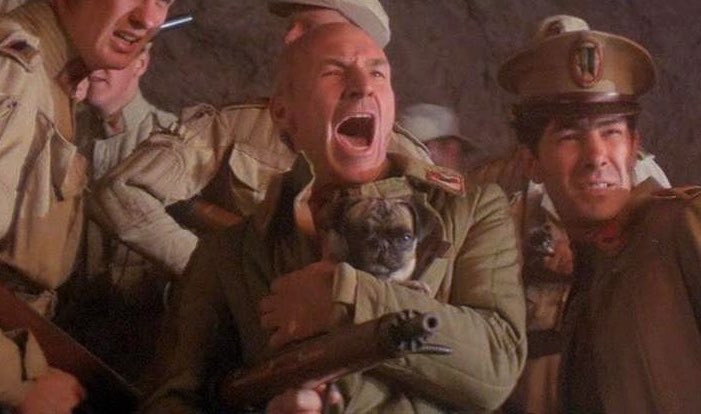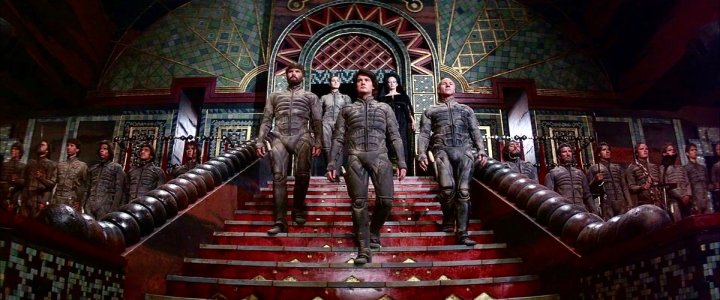The arrival of Denis Villeneuve’s Dune in theaters is kind of a big deal — and not just because it’s one of the biggest projects released since the pandemic changed the movie business. The blockbuster film is already breaking box-office records, and it’s prompted many movie and sci-fi fans to take another look at the previous attempt to bring novelist Frank Herbert’s saga to the big screen: David Lynch’s much-maligned 1984 film of the same name.
And you know what? After re-watching it myself, I feel confident suggesting Lynch’s messy, wonderfully weird Dune isn’t nearly as terrible as you might remember — and might be worth watching again nearly 40 years after it first hit theaters.
Ambitious beginnings
The project that would eventually become the big screen’s first Dune movie had a long road to release, to put it mildly. More than a decade of starts and stops and a revolving door of filmmakers preceded executive producer Dino De Laurentiis’ 1981 announcement that Lynch would direct the film. Fresh off directing The Elephant Man, Lynch was a novel choice to helm the film, and he ultimately chose to direct Dune over Star Wars: Return of the Jedi.
It’s a decision he likely regrets now, having disavowed the theatrical cut of Dune after its release. Plus, one can’t help but imagine what Return of the Jedi might have looked like with Lynch behind the camera. The Ewoks would probably be a lot creepier, to start.
One of the most expensive films ever made at the time, Dune featured elaborate, gorgeous sets and a massive team of effects artists and crew to bring Lynch’s vision for the tale to the screen. The film also assembled a cast of experienced and up-and-coming actors who would go on to become household names with long, accomplished careers, including Kyle MacLachlan, Sean Young, Brad Dourif, Virginia Madsen, Patrick Stewart, Max von Sydow, and Dean Stockwell — among other now-familiar faces. For good measure, the film even cast a rock star, Sting, as one of the film’s primary antagonists.
What could go wrong? Apparently, everything.
The wildly ambitious film, which attempted to cram the entirety of Herbert’s original novel into a two-hour presentation, ended up being a hodgepodge of confusing plot points and expositional voiceovers used to connect one scene to the next. It was also peppered with Lynch’s trademark psychedelic imagery and trippy camera work. Seemingly uncertain of the story it wanted to tell or the film it wanted to be, Lynch’s Dune flopped both critically and commercially and led to nearly three decades of belief that Herbert’s saga was uniquely unfilmable — until Villeneuve came along, of course.
But nearly 40 years later, is Lynch’s Dune really deserving of all the hatred? Seen through fresh eyes, you might be surprised by some of the elements that make it weirdly worthy of a re-watch.
Only in 1984…
Given how massive of a story Villeneuve is hoping to tell with his two-part Dune adaptation — expected to encompass around five hours of running time — it feels strange to suggest that Lynch’s film actually includes quite a bit of the source material that the modern movie has, thus far, left out.

Lynch didn’t shy away from leaning into some of the story’s weirdest elements, for example, and devoted quite a bit of screen time — for good or ill — to the massive, mutated Guild Navigators who relied on Spice from the planet Arrakis to “fold space” and make interstellar travel possible. The Navigators are humans who have been horrifically mutated into worm-like forms by constant, concentrated exposure to Spice. They bend time and space using a form of Spice-fueled prescience and energies that emanate from flappy, dripping orifices on their bodies that let them transport vessels far distances without actually moving.
Yes, you read that last line correctly, and yes, Lynch put them and their sloppy, surreal space-folding abilities front and center in Dune. Amazingly, despite playing a key role in both the story’s universe and the events that lead to protagonist Paul Atreides’ (MacLachlan) ascension, they’re nowhere to be found in Villeneuve’s adaptation up to this point — which is maybe for the best, although others might disagree.
Too weird?
The Dune of 1984 also offers an interesting twist on an element of Herbert’s novel that Lynch deemed too inconceivable even by his standards: A form of magical martial arts practiced by the Bene Gesserit — and Paul — known as “The Weirding Way.”

Lynch reportedly considered the Weirding Way, which mixes martial arts with a form of short-distance teleportation, to be too weird for his film. Instead, he invented powerful, sonic weaponry called “Weirding Modules” to replace the original story element he called “Kung Fu on sand dunes.” As one might expect, the decision polarized fans of the original story, but the devices, which turn specific, audible phrases into powerful blasts of energy, remain an otherwise unique spin on traditional, sci-fi laser guns that fit surprisingly well in the film’s world.
And yet, that wouldn’t be the only new element Lynch brought to his Dune, which also added a recurring, four-legged character to the story that you’ll only find in this particular version of the tale.
Pugs make everything better
In one of the greatest mysteries surrounding the film, Lynch chose to give the ill-fated House of Atreides a pet dog — specifically, an adorable pug. The pug plays a recurring role throughout the film, first introduced along with the members of the royal family, then seen again on their journey to Arrakis, and later seen both during and after the attack on the Atreides’ desert home. Lynch’s desire to feature the pug is clearly intentional, too, as the little dog is shown wandering through a hallway filled with dead bodies in one scene, and later, in its most memorable appearance, appears in the arms of House Atreides’ soldier-at-arms Gurney Halleck (Stewart) as he charges off into battle.

Lest anyone get concerned about the pug’s status in the story’s later chapters, the pug appears once more during Paul’s climactic fight with Feyd-Rautha (Sting), happily alive and placidly staring, tongue lolling (in that very pug-like way) at the events transpiring around it.
Okay, so it’s not exactly surprising that Villeneuve’s Dune didn’t carry over this addition to the mythology provided by Lynch, but it’s a little disappointing.
Scope and scale
Beyond the specific elements that Lynch translated for his adaptation of Dune or added new to the story, there’s some credit that deserves to be given for the over-arching vision he had for the saga, too.
No one can, or should, argue that the world of Villeneuve’s Dune lacks scale, vision, or meticulous visual execution, but it’s just as difficult to make a case against the tremendous achievement of visual spectacle that Lynch’s film delivered at the time. From the desert vista of Arrakis that looms over and behind every shot to the impressively weighty visualizations of the planet’s sandworms, Lynch’s Dune occasionally offered up some gorgeous set pieces amid all the messy storytelling and jarring edits.
We have yet to see Timothée Chalamet’s Paul Atreides mount and ride a sandworm in Villeneuve’s Dune, but it was certainly a sight to behold when MacLachlan did it way back in 1984.

Credit where it’s due
None of this is intended to suggest that Lynch’s Dune is better than Villeneuve’s film. The former’s flaws are well-documented, and in many cases, the criticisms are well-deserved, while the latter is a masterpiece of spectacle and substance in equal measures.
However, it isn’t often that we get to see a story as singular and fantastic as Dune interpreted by two wildly different filmmakers unique in both their vision and their technique. Sure, it’s easy to dismiss the 1984 film as one of Hollywood’s most infamous flops and leave it at that, but if you take the time to give it a re-watch — or even watch it for the first time — you might be surprised by some of the fascinating corners it explores and the elements of Herbert’s story it spotlights, both visually and narratively.
Remakes and reboots are nothing new these days, but rarely have two adaptations of the same story felt so remarkably different and unique. Approach Lynch’s Dune with an open mind, and there’ll be plenty of enjoyment to be found in one of the sci-fi genre’s most infamous Hollywood misfires.
And honestly, it’s worth it just to see Patrick Stewart charge into battle with a pug strapped to his chest.
Both David Lynch’s Dune and Denis Villeneuve’s Dune are available to watch now on HBO Max.





